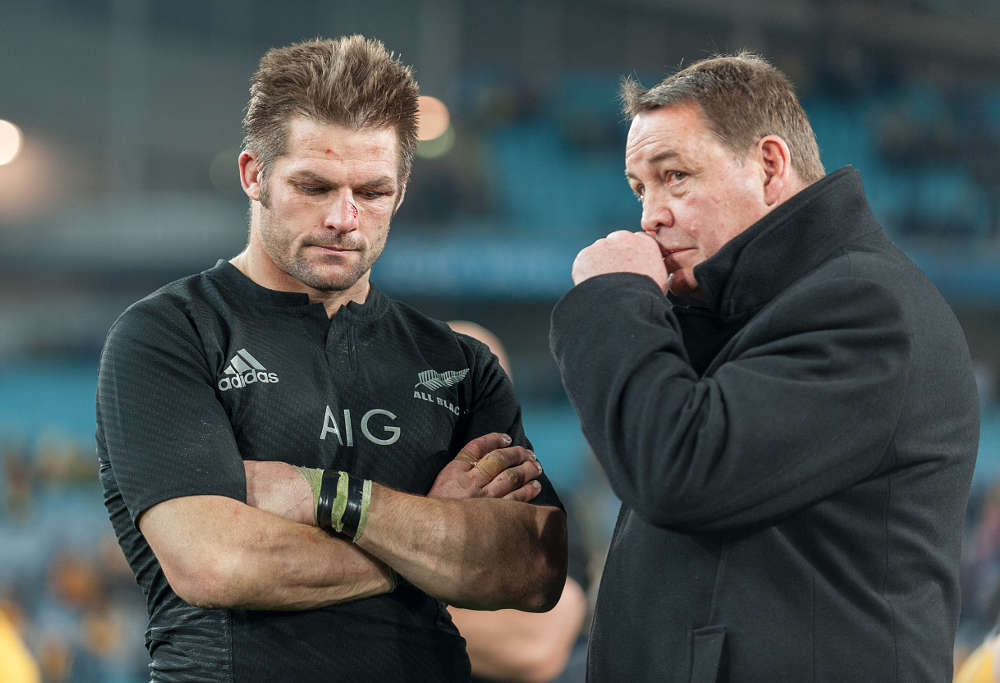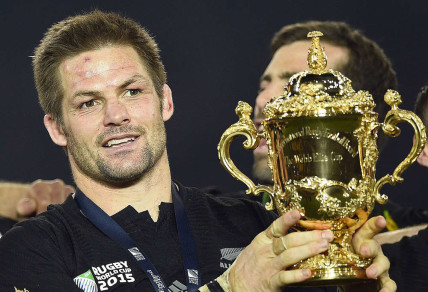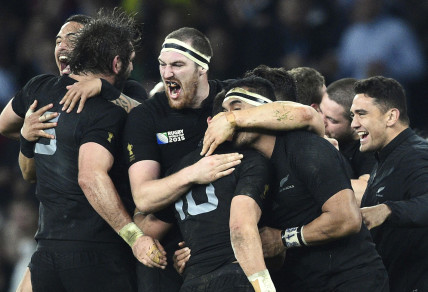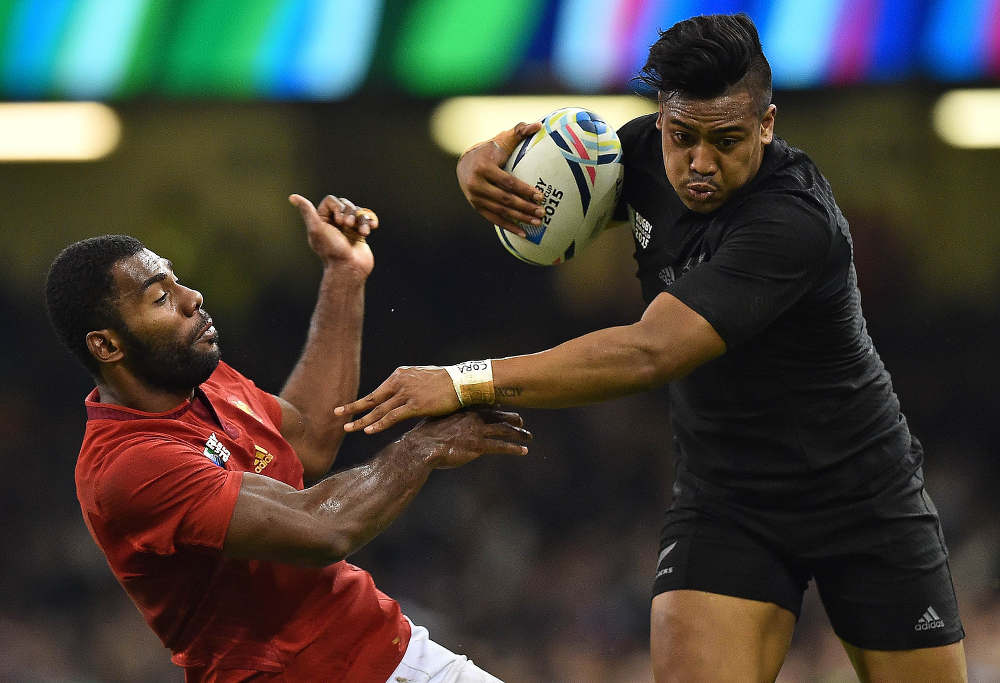If there is a single international sporting phenomenon which marks the early 21st century, it is New Zealand’s extraordinary dominance of rugby.
Once upon a time, Brazil ruled the world when it came to soccer, ditto for the United States in basketball. Australia has been the leading light at cricket, on and off, and at women’s netball most of the time.
But none of these comes even close to New Zealand’s increasingly comprehensive sweep of rugby titles across the board. It is unimaginable that the All Blacks would succumb the abject way the once great Brazil did at the hands of Germany at the last football World Cup.
Think about the sheer scale of this. New Zealand teams have won the men’s World Cup, the women’s World Cup, the age group championship and World Sevens tournaments with monotonous regularity.
The All Blacks are the first team to win back-to-back Rugby World Cup titles. The Black Ferns have done that several times and are, perennially, the team to beat, as are the Junior All Blacks, who have won the world title more than any other country. As for the sevens, the New Zealand team has won 12 of 16 titles, even if some wobbles have occurred along the way.
The most remarkable thing is the consistent and comprehensive manner of New Zealand’s success has occurred in an environment where standards are constantly rising.
Rugby is no longer a small niche sport catering to a few offshoots of the British Empire. This century it has grown from an exclusive club of largely Anglo-saxon lookalikes to a truly global sport which has well over a hundred countries competing in one international tournament or another.
“New Zealand wasn’t as naturally egalitarian in the late 19th century as we sometimes like to think it was”
The Rugby World Cup is the third largest sports tournament in the world. It’s big business, yet the dominant participant in this great firmament is a very small country.
How did it come about? Social historians have been perplexed by this question ever since it became evident that New Zealand, along with South Africa, had emerged as rugby’s two superpowers.
Over the years there has been a sense of wonderment that a game, ostensibly the product of the English public school system, invented as a means of diverting teenage boys’ minds from such subversive subjects as sex or socialism, and more or less ignored by the great unwashed of Britain, should take root in a fiercely egalitarian society like New Zealand.
But New Zealand wasn’t as naturally egalitarian in the late 19th century as we sometimes like to think it was. The private schools, taking their cue from their British role models, adopted rugby with copycat enthusiasm and, because it all involved a certain amount of assault and battery, it couldn’t help but appeal to the knockabout classes in the colony.
In the space of a few years rugby went from nothing to a national sport. It hasn’t looked back.
 The brains trust (Photo: Tim Anger)
The brains trust (Photo: Tim Anger)
Rugby leapt almost immediately beyond its middle-class beginnings to serve as a marvellous leveller in New Zealand society. It was something that New Zealanders from all stations in society could share and so it embedded itself in the national psyche like nothing else.
There is a theory, popularised by Richard Dawkins and others, that a physiological phenomenon known as a meme could be self-reinforcing through the generations. Perhaps a rugby meme exists among New Zealanders. It would certainly help to explain rugby’s extraordinary grip on the imagination of generation after generation.
Rugby was New Zealand’s way of taking on other countries and giving them a physical belting as a substitute to being internationally competitive in arts or letters or entertainment.
New Zealanders would look to Europe for their artistic or aesthetic inspiration but it gradually became apparent that Europe would look to New Zealand for inspiration on a football field.
For much of the 20th century New Zealand artists, writers and musicians tried to establish a local voice, but an identity that was distinctive from Europe’s took the best part of that century to develop. The All Blacks achieved it almost instantly.
Half a century later – despite the fact that New Zealanders have come to excel in so many other fields of enterprise on a world stage – rugby remains firmly embedded as the primary symbol of New Zealand’s presence on the world stage. The silver fern became a symbol of what this little society did better than anybody else and it’s no surprise that there would eventually be a movement to have the fern replace the Union Jack on the national flag.
Since 1905 rugby has been a barometer of national feelgood for New Zealanders. That landmark tour generated an immense surge of pride for a young colony which had essentially set out to mirror British society – albeit with an unspoken ambition to do so better than the British had.
When it became obvious that our hardened, more athletic team were both faster, stronger and more clever than their British opponents, questions even began to be asked about the quality of British manhood.
All the hoopla which surrounds Gallipoli as the moment New Zealand realised that it was something more than just a branch office of an empire was actually preceded by the realisation which flowed from the 1905 tour; New Zealand was a different sort of society from Britain. It had, in its own way, discovered itself through the reaction in Britain to the team’s superiority on the footy field.

New Zealand captain Richie McCaw, a Great All Black. (Photo: AFP)
Our national personality was woven into the All Black jersey. Our nationalism was one provoked by the immediate circumstances of winning or losing at rugby. To lose to any other country was almost a form of cultural capitulation.
When I played in the 1960s the importance of winning to defend an uncertain national identity was an unspoken holy writ. A defeat was akin to a savage kick in the private parts of that identity. Thus, we would invest every ounce of energy into winning, well before the professional era ushered in the material rewards that provide today’s athletes with extra motivation.
This apparent fanaticism came as a bit of a shock in some quarters, England in particular, when it was realised that a bunch of humble colonials could outplay their home-grown heroes. For New Zealanders, however, it produced an adrenalin rush that began to build a sense of certainty that on our day nobody else in the world could beat us.
Wales and South Africa stood out as the early obstacles to that primacy but gradually the balance of power shifted, and by the late 20th century it was acknowledged that the All Blacks were the number one team in the world. The winning percentage began to track inexorably upwards and that trajectory has continued to rise to the point where no other sports team in the world comes even close by way of comparison.
One of the other determinants of New Zealand’s success internationally is the success of its healthily non-racial character. It has come to be the source of much pride within the wider society, even if it had a somewhat tortured history.
Maori rugby has been a distinctive element of the New Zealand game for a very long time. Maori communities, having seen and obviously relished the intense, physical confrontation that rugby represents, threw themselves at it.
Their integration into the game wasn’t, however, immediate. Maori communities would field their own teams in their own competitions in rural areas largely because there was nobody else around to play against.

Gradually, as Maori communities began to urbanise, they began to filter into the Pakeha competitions, uneasily at first but increasingly with comfort, reinforced by the fact the Maori were natural athletes and more than able to hold their own against the boys from the settler societies.
But the Maori, being Maori, were determined to preserve their own identity within the game and insisted that a national Maori team be retained as part of the overall machinery of the game. Over the years this distinctive sub-national presence has served to remind New Zealanders they are part of New Zealand society but not dissolved within it. It has been the best of all worlds for New Zealand rugby and it has produced a wonderful example of the comfort that comes from genuinely workable biculturalism.
This special character was given vivid expression when the so-called Natives team went off to Britain in 1888 to play countless games against anyone who was prepared to take them on. This, too, was something of an eye-opener for British audiences who had only the vaguest notion of who the Maori were – a notion imbued by imagery of cannibalism and a devotion to constant war.
“The haka has gained in importance and significance as a not-so-secret weapon”
The British were forced to accept the reality that New Zealand was rather more than a white society marshalling a few remnants of Polynesia in their own interests. The Maori were exceptionally assertive – as they have been ever since – and the British media were obliged to admit that if a bunch of erstwhile natives can be persuaded to play a gentleman’s game, if not in quite a gentlemanly manner, then the colonisation of New Zealand may not have been a waste of Britain’s time after all.
Countless Maori players have been the stars of their respective eras; standout players possessed either exceptional energy, strength or speed. From George Nepia to Nehe Milner-Skudder the contribution has been profound and a key factor in the success of so many teams.
Other nations have never been quite sure how to deal with the phenomenon of Maori rugby. At times there have been suggestions, accusations even, that a team representing one racial group was inappropriate.
South Africans, during the dark days of apartheid, suffered great discomfort at the presence of Maoris in the All Black teams. It took a long time to extricate ourselves from the nasty web that apartheid wove around sport, but it was an insistence by New Zealand society – that if Maoris weren’t invited then the All Blacks should be disinvited – which helped consolidate the non-racialism of New Zealand rugby and lend it a strength that has been one of its strongest suits ever since.
Over many decades the haka, that curiously privileged unilateral ritual that characterises every Test match the All Blacks play, has gained in importance and significance as a not-so-secret weapon. Critics often see it as pandering to a national New Zealand conceit. Criticising the haka has become something of a call to arms for British rugby writers who derive a vicarious pleasure in mocking anything that smacks of ‘native.’
In 2008, Guardian columnist Frank Keating called for an end to a “once diverting wheeze that has long passed its sell by date.” In case readers hadn’t quite got his drift he called the haka a “native rumba,” a “danse macabre,” and “an over-rehearsed, over-choreographed production number with a nasty malignant edge to it.”
At one level Keating was right. The haka has been something of a slow burning fuse for the All Blacks. A generation ago it was a decidedly unintimidating spectacle, performed in a half-hearted, incompetent and rhythm-free way by teams that only had a passing acquaintance with its history and real meaning.
That changed as the consciousness of the power of biculturalism took hold in New Zealand. A decade or so ago it was given what looked like a malignant edge when a stylised throat slashing movement was added to a new haka designed to replace the old Te Rauparaha version. It became what looked to opponents like a deliberate act of one-upmanship, playing on the nerves of opponents who, out of courtesy, were obliged to stand and watch it.
Happily, we seem to be past that confrontational mode. The haka is marginally more restrained but the message remains the same. This is a challenge that we, the world’s number one team, lay down to any and all who dare to take us on. If that isn’t intimidation I’m not sure what is. One can appreciate the apprehension it generates in opponents who have to face it.
But one should never forget that the haka is also a pointer to why New Zealand rugby is such a force; it derives from an intense mutual pride by both Maori and Pakeha. There is nothing like it in international sport and when this spirit is translated into action on the field it’s almost a third leg.

Another factor which gives New Zealand rugby an edge is the extraordinary production line of Pacific Island players. Whether they are born in New Zealand or elsewhere in the Pacific doesn’t make a lot of difference – except of course to the numerous critics from abroad who proclaim that without the Pacifika ring-ins the All Blacks could never possibly be world champions.
They, of course, fail to acknowledge that talent scouts from their own rugby communities are scouring the Pacific for talent to buy, rent or poach. Pacific islanders are popping up all over Europe. They are a multiple presence in Japan and some are even finding their way to South Africa and Argentina. Fijian wingers feature all over the world. There are enough, it seems, for all the world to share. Samoan props and Tongan loose forwards likewise.
Or are there? Inevitably this one-way trade has weakened the island countries’ strength at the top level, but for New Zealand and other major rugby countries it is a low-cost bonanza.
The truth is, however, that New Zealand doesn’t have to rely on a steady flow of island imports. It already has a healthy lead on all the other rugby playing countries in that it has a relatively large and settled Pacifika population, the product of inward migration over many decades.
Tongans, Samoans and Fijians took to rugby like ducks to water. They constitute a very solid minority of just about every rugby team in the land; in Auckland they have become the majority ethnic group at many levels of the game and it is not beyond the realms of possibility that in a decade or two a white face may be a rarity in many teams.
It’s certainly true that, at schoolboy level, the Pacific Islanders are bigger, stronger and often faster than their Pakeha counterparts – painfully so as many young Pakeha players can readily attest. Some say that in the long run this might turn into an ethnic zero sum game, as did Black dominance of American football and basketball.
Does that matter? Probably not. And in New Zealand rugby it seems unlikely, as ethnic diversity is regarded as a strength rather than a weakness, and the results of that are obvious enough on the field.
One of the most compelling reasons why New Zealand rugby is stronger than all of its competitors lies in its structures and systems.
All around the country the pathways to excellence are well established and intensively competitive. Rugby remains fundamentally strong at school level, reinforced by every success at the international level – by the men, the juniors the women and the sevens teams.
The age group nurturing of talent is and competition is intense and the provincial competitions are a tough and competitive apprenticeship for the next step up to professionalism. The production line of players is well oiled and very efficient.
“And in New Zealand rugby it seems unlikely, as ethnic diversity is regarded as a strength rather than a weakness, and the results of that are obvious enough on the field”
Perhaps even more importantly the New Zealand system is not split at its professional peak by competing interests. Unlike the arrangements in most other major rugby-playing countries, the New Zealand Rugby Union preserves wide controls over player contracts, salaries and other conditions.
There is very little private ownership of the Super Rugby franchises and New Zealand rugby seems to prefer it that way. A few years ago, when the game’s financial security was under threat, it seemed almost inevitable that the franchises would have to be opened up to private investors.
That didn’t happen and, as a result, there are none of the ugly disputes that we see between home unions and the big clubs elsewhere in the world.

In France and England in particular, players are mere commodities in the competing marketplace of the national game. Disputes over availability as between club and national teams often lead to debilitating standoffs and are hardly conducive to the collective morale of the game in those countries.
This greater sense of family within the New Zealand rugby community is a crucial factor behind the single-mindedness in the game in the country. There is no doubt it contributes to a more robust democracy in rugby and that in turn stimulates an unqualified national pride in the game.
New Zealand, more than any other rugby playing country, has exported its talent and expertise all over the world, driven by its phenomenal success rate.
Half of the world’s professional coaches are New Zealanders. New Zealand players are sprinkled liberally all over the world in amateur and professional competitions. New Zealand referees and tactical and technical advisers are in hot demand everywhere. It is interesting to speculate whether these various exports – some of them temporary, some permanent – are going to enhance or weaken New Zealand’s position at the top of the rugby pole. We will probably never know the answer to that.
I suppose that, like Brazil, New Zealand will eventually have to yield its supremacy of a football code. There are some signs, in sevens for instance, that New Zealand is being caught by the competition.
Even if that happens more frequently, and this unique competitive advantage is no more, we will at least be able to say it was unbelievably good while it lasted.
About the author
Chris Laidlaw is a legendary All Blacks halfback and captain, playing 57 matches for New Zealand after making his debut in 1963. Chris has worked in broadcast and written media since his retirement as a player, and has been a Roar columnist since 2009. Chris has also served in New Zealand parliament, and as a Wellington councillor, having been re-elected three times running.
Editing and design by Patrick Effeney
All images copyright AAP Australia




























































































